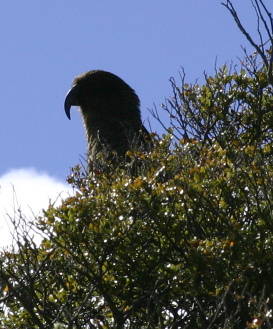
|
|
My first shot of a Kea; but Mark got better this day, and we both got much better shots on the day we went to see the Rob Roy Glacier |





|
|
My first shot of a Kea; but Mark got better this day, and we both got much better shots on the day we went to see the Rob Roy Glacier |
After lunch, we drove a short way to a “forest park”, for a nice walk uphill amidst a virtual monoculture of Nothofagus solandri, informally called “black beech”. These are the same genus as the Nothofagus antarctica we saw so much of in southern Patagonia three years ago, but rather different looking. For one thing, they’re black because of a thick fungus or mildew that grows on them, or rather on the honeydew produced by a parasitic scale insect that lives on the bark.
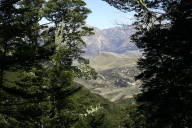
The forest was fairly dense, and presented relatively few opportunities for snapshots, but to the left (big image, small) is a shot I took looking out through the woods to a valley down below. The most prominent tree-trunk in the picture shows clearly the incrustation of fungus, plus plenty of lichen.
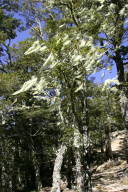
|
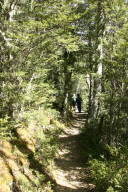
|
Speaking of lichen, there was another kind that was very much in evidence, a long flowing pale green-gray one, as you see in the first picture to the right. (Big image, small). The second picture to the right, taken on the walk back down, shows very nicely what the forest looked like. (Big image, small.)
Once we got to the top of our path, pretty much above the tree line, the views were much better. the two pictures below give some idea. The left one is photographically adequate (big image, small), but I didn’t bother to put up larger versions of the right one.
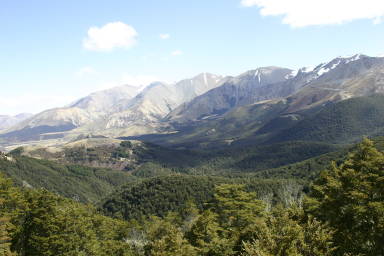
|
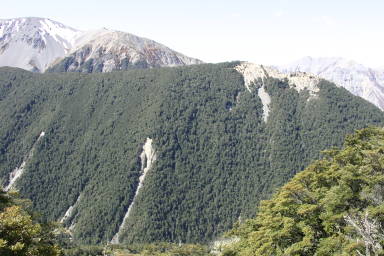
|
Up at the top, we relaxed, and one or two of us put their packs down on the ground. “A Kea,” Nicky said: I think she recognized its call. In a few moments, there it was, this huge parrot in a tree, you can see my one picture up top, and during the next ten minutes or so, the bird tried to approach the packs on the ground. It would seem that they are not only real mischief-makers, getting into anything they can, edible or not, but they especially like to try to find anything edible in a pack. New Zealand’s much less threatening version of park bears, in other words. It’s strictly against the rules to feed them, but they are such handsome birds that there’s no doubt that people do bend the rules in this case. We were very responsible, not only during this meeting with the world’s only alpine parrot, but later, when we were able to get much closer to a couple of them.
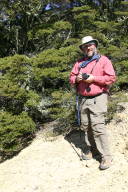
|
|
While we were up there at the top, we relaxed a while, admiring the few views of the kea that we could get. I took the left shot of Mark while we were up there (big image, small), and then we started down. As I recall, and as my journal confirms, it was a relatively difficult descent, because it was fairly steep, and so something of a strain on the ankles and knees. Anyway, I took the upper picture in the righthand column at a relatively level part of our descent (big image, small).
At the bottom was our welcome bus, and a nice drive past Lake Pearson took us to the lodge where we would be staying, the Wilderness Lodge at Arthur’s Pass. This is a very elegant yet unpretentious (this is New Zealand, after all!) place, very roomy and with fine facilities. At the same time, it’s a working sheep station, where sheep are raised, sheared, and sent off to other locations for slaughter.
As soon as we got in, we dumped our packs, and went right out for a demonstration of sheep-shearing. It’s is not the sort of thing that this old geezer is much interested in, but I watched in good spirit, and in fact with more interest than I would have predicted. But afterwards was something truly wonderful, which I’m sorry that I was unable to take pictures of, simply because it hadn’t occurred to me that it might be wise to take my camera with me.
The sheep farmer showed us how he runs his dogs. There were two dogs about, rather scruffy and not your cute little Sheltie by any means. The farmer mentioned a dog’s name, and then without words but with a whistle of a design that I’ve never seen before, directed the dog he had spoken to to move the small herd of sheep to gather together, and then to come to the fence closest to us. It was truly amazing. And then he spoke to the other dog by name, and she did the same thing with three big bulls that were in a different part of the field. The sight of huge bulls being controlled by a fairly small dog was truly thrilling, and something I don’t think I’ll soon forget.
After that, we returned to our room and took a welcome shower, then over to the lounge, where you see Mark in the lower picture in the right-hand column (big image, small). And a nice glass of New Zealand wine before dinner, which was notable for a superb seafood chowder as a starter.
Next day’s pictures, first batch of pictures from this day, previous day’s account. Return to the central New Zealand page; to the central travel page; to my home page.
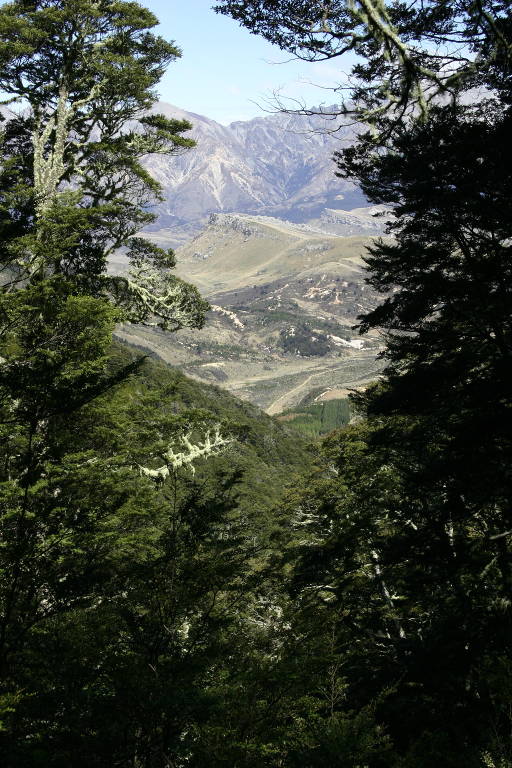
|